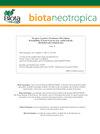Diet of Moenkhausia bonita (Benine, Castro & Sabino 2004) (Characiformes: Characidae) in streams in the basin of rio Formoso, Brazilian Midwest
IF 1.2
4区 环境科学与生态学
Q3 BIODIVERSITY CONSERVATION
引用次数: 0
Abstract
Abstract To characterize the diet composition of Moenkhausia bonita and its temporal and ontogenetic variations in streams in the Formoso River basin (MS). The collections were carried out in seven sampling points in two periods throughout the year (dry and rainy). The food items were analyzed according to the volumetric and occurrence frequency methods and the diet was characterized through the Food Index (IAi%). To determine ontogeny, the specimens were divided into five size classes in the dry (D1 to D5) and rainy (R1 to R5) periods. To verify the difference between the species’ diet between the size classes and the periods of the year, the Permutational Multivariate Analysis of Variance – PERMANOVA analysis was performed. Moenkhausia bonita was classified as an invertivore when it consumed basically both aquatic and terrestrial invertebrates (99.5% of the diet), with higher consumption of aquatic invertebrates. There was a significant difference in the diet of between the dry and rainy periods, and although the species basically consumed the same items in the two studied periods, the proportions were different and there was no difference in the diet between size classes. M. bonita diet is based on autochthonous resources regardless of the size class, but that there were different consumption patterns when comparing the different periods of the year. The present study provided the first information on the feeding of M. bonita in a lotic environment and diet spectrum in the developmental phases, (ontogeny) and periods of the year, enabling a better understanding of the species, the importance of invertebrates in its diet, and the need for future studies on the biology, autoecology, and behavior of this species.巴西中西部福尔摩索河流域河流中蒙卡西亚·博尼塔(Benine, Castro & Sabino 2004)(特征:特征科)的饮食
摘要:研究台湾福尔摩索河(MS)河流中白鲑(Moenkhausia bonita)的食性组成及其时间和个体发生变化。收集工作在全年两个时期(旱季和雨季)的七个采样点进行。采用体积法和发生频率法对食物进行分析,用食物指数(IAi%)对饮食进行表征。在干旱期(D1 ~ D5)和多雨期(R1 ~ R5),将标本分为5个大小级。为了验证不同体型类和不同季节的食性差异,采用Permutational Multivariate Analysis of Variance - PERMANOVA分析。当它基本上同时食用水生和陆生无脊椎动物(占其饮食的99.5%)时,它被归类为无脊椎动物,其中水生无脊椎动物的食用量更高。枯水期和丰水期的食性存在显著差异,虽然两个时期的食性基本相同,但食性比例不同,体型类之间的食性没有差异。鲣鱼的饮食以本地资源为基础,无论大小类别,但在比较一年中的不同时期时,有不同的消费模式。本研究首次提供了关于bonita在自然环境中摄食的信息,以及在发育阶段(个体发育)和一年中的各个时期的饮食谱,使人们更好地了解该物种,无脊椎动物在其饮食中的重要性,以及对该物种的生物学,自生态和行为的进一步研究的必要性。
本文章由计算机程序翻译,如有差异,请以英文原文为准。
求助全文
约1分钟内获得全文
求助全文
来源期刊

Biota Neotropica
BIODIVERSITY CONSERVATION-
CiteScore
2.90
自引率
16.70%
发文量
0
审稿时长
4-8 weeks
期刊介绍:
BIOTA NEOTROPICA is an electronic, peer-reviewed journal edited by the Program BIOTA/FAPESP: The Virtual Institute of Biodiversity. This journal"s aim is to disseminate the results of original research work, associated or not to the program, concerned with characterization, conservation and sustainable use of biodiversity within the Neotropical region.
Manuscripts are considered on the understanding that their content has not appeared, or will not be submitted, elsewhere in substantially the same form, because once published their copyrights are transferred to BIOTA NEOTROPICA as established in the Copyright Transfer Agreement signed by the author(s).
 求助内容:
求助内容: 应助结果提醒方式:
应助结果提醒方式:


